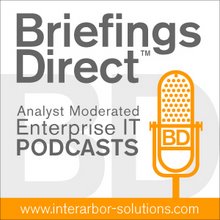Especially important for the operational control of hybrid services delivery and converged cloud implementations, CMS 10 gathers and shares the configuration patterns and characteristics of highly virtualized workloads. The update helps manage dynamic virtualized applications both inside enterprise data centers as well as leading clouds.
"CMS 10 improves control of converged clouds," said Jimmy Augustine, product marketing manager at HP Software. "It sees the virtual machines and updates the Universal Configuration Management Data Base (UCMDB) with the dynamic information from public and private clouds."
With the new software, HP says clients can reduce costs and risks associated with service
 disruptions while reducing the time spent on manual discovery by more than 50 percent thanks to automated discovery capabilities. [Disclosure: HP is a sponsor of BriefingsDirect podcasts.]
disruptions while reducing the time spent on manual discovery by more than 50 percent thanks to automated discovery capabilities. [Disclosure: HP is a sponsor of BriefingsDirect podcasts.]With the growing adoption of cloud computing, organizations are under increased pressure to deliver new services and scale existing ones. The complexities of cloud-based infrastructures coupled with a lack of visibility have hampered organizations’ ability to efficiently and predictably manage IT performance.
“Service disruptions within complex cloud and virtualized environments are difficult to identify and resolve,” said Shane Pearson, vice president, Product Marketing, Operations, Software, HP. “With the new enhancements to HP Configuration Management System, IT executives now have the configuration intelligence they need at their fingertips to make rapid decisions to ensure consistent business service availability.”
CMS 10 also introduces new capabilities specifically for service lifecycle design and operations, notably within both business service management (BSM) and IT service management (ITSM).
CMS 10 also introduces new capabilities specifically for service lifecycle design and operations.
I was especially impressed by the ability of CMS 10 users to extend the view of operations to business process analysts, enterprise architects and DevOps managers -- all provided by a new browser-based access and query capability. These business-function-focused leaders can seek out the information they need to cut through the complexity of systems data to measure and react to how an entire application or processes are behaving systemically.
What's more, CMS 10 level insights can be extended to security professionals and business architects to gather data on compliance, performance, and even for better architecting the next process or hybrid services mix. The fact that CMS 10 already supports across many VMs and cloud types shows the importance of ensuring configuration conformity as a baseline capability for hybrid cloud uses.
The CMS update broadly supports virtual machines better, has multi-tenancy support to appeal to service providers, and delivers its outputs via web browsers and search interfaces. "You can see the full applications support infrastructure, and discover out of the box the whole workload support," says Augustine.
More specifically, the new HP CMS 10 includes HP Universal Discovery with Content Pack 11, HP Universal Configuration Management Data Base (UCMDB), HP UCMDB Configuration Manager, and HP UCMDB Browser. With the new solution, enterprises, governments and managed service providers (MSPs) can now:
- Quickly discover software and hardware inventory, as well as associated dependencies in a single unified discovery solution
You can see the full applications support infrastructure, and discover out of the box.
- Speed time to value with the product’s simplified user interface and enhanced scalability, allowing all IT teams to consume as well as use rich intelligence hosted in the HP CMS
- More easily manage multiple client environments within a single UCMDB with improved security, automation and scalability
- Automatically locate and catalog new technologies related to network hardware, open source middleware, storage, ERP, and infrastructure software providers
- Introduce new server compliance thresholds.
HP CMS, currently available worldwide in 10 languages, is also available through HP channel partners. More information about CMS 10 is available at www.hp.com/go/CMS.
You may also be interested in:
- Investing Well in IT With Emphasis on KPIs Separates Business Leaders from Business Laggards, Survey Results Show
- Expert Chat with HP on How Better Understanding Security Makes it an Enabler, Rather than Inhibitor, of Cloud Adoption
- Expert Chat with HP on How IT Can Enable Cloud While Maintaining Control and Governance
- Expert Chat on How HP Ecosystem Provides Holistic Support for VMware Virtualized IT Environments







